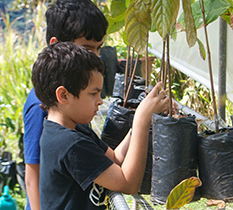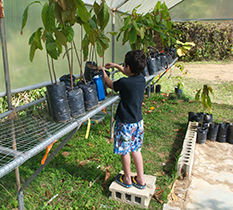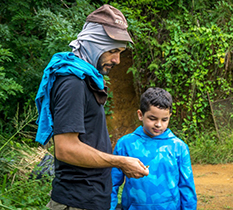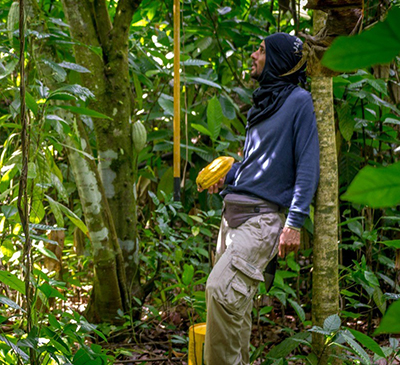Chocolate science, history and fun facts – Part 5: Cacao farming in Puerto Rico
Learn how one cacao farmer’s interest in cacao production is helping to revive the cacao industry in Puerto Rico.

Puerto Rico has an interesting cacao story. Prior to coffee and sugarcane becoming the first and foremost cultivated crops, cacao and ginger were at the top. It is written that some natural phenomenon, likely a hurricane, in the 17th century caused the people to abandon cacao as a viable crop.
José D. Crespo de León is a cacao farmer in the north central part of Puerto Rico near the town of Corozal. This is a beautiful part of Puerto Rico with incredible views of the Rio Grande de Manati. Crespo de León’s farm originally belonged to his brother, who planted the first cacao tree from seed on the farm, as well as fruit trees and trees for timber.
After moving to the farm, Crespo de León was fascinated with the partially neglected adult cacao tree his older brother planted as it was producing pods in abundance. Crespo de León admits he was bitten by the Theobroma cacao bug; Theobroma cacao or cacao tree is the Food of the Gods, in other words it is the Chocolate Tree.
As Crespo de León’s interest in reviving the cacao industry in Puerto Rico grew, he began studying everything chocolate. His interest was pure intrigue and love of the process of creating a high quality chocolate using sustainable practices. Much of his inspiration came from Mott Green who started the world’s first chocolate factory bean to bar on the small county of Grenada. Grenada is a small Caribbean island located northwest of Trinidad and Tobago, northeast of Venezuela. Mott’s dream was to produce chocolate from bean to bar distribution in the most sustainable way possible, honoring the land by using sustainable practices, honoring the people and ensuring they were paid fair wages for their cacao beans. To learn more about Green and his intriguing romance with chocolate, view this documentary film, “Nothing Like Chocolate.”
Crespo de León stated he was, “Fascinated in the germination process, the flowering, pollination, learning to graft, smell and taste.” He has been studying everything chocolate for the past three years and is fascinated with learning all he can about the complex processes involved in creating great chocolate from the tree to bar. He said, “I just couldn’t stop reading and trying to understand everything.” He went on to say, “I just love to do/create things. Also, to motivate my kids to do what they love and put passion into it.”



Crespo de León and his children, Gadiel (8 years old) and Gabriel (12 years old), during the earlier stage of his project when they started grafting the first trees.
Crespo de León uses an agroforestry system approach that mimics the interactions between plants in the forest. He also uses nitrogen fixing plants and trees and other crops and species to provide the appropriate shade to the cacao trees. He is very proud his cacao is also chemical-free.
 He designed and constructed a fermentation box from local timber. There, the “baba,” which are the seeds and sugary pulp, starts a process of anaerobic fermentation followed by aerobic fermentation. During this process, temperatures rise to about 118-120 degrees Fahrenheit. During this second phase, the heat is technically “killing" the seed and changing the chemical composition inside the bean so precursors to chocolate flavors are created. This is a critical process for creating high quality chocolate. After that, the beans are slowly sun dried, reducing moisture content to about 7 percent. At this point the beans are suitable to be further processed or appropriately stored.
He designed and constructed a fermentation box from local timber. There, the “baba,” which are the seeds and sugary pulp, starts a process of anaerobic fermentation followed by aerobic fermentation. During this process, temperatures rise to about 118-120 degrees Fahrenheit. During this second phase, the heat is technically “killing" the seed and changing the chemical composition inside the bean so precursors to chocolate flavors are created. This is a critical process for creating high quality chocolate. After that, the beans are slowly sun dried, reducing moisture content to about 7 percent. At this point the beans are suitable to be further processed or appropriately stored.
Research is continuing in Puerto Rico as to the viability of cacao as a cash crop, and there is a growing interest in the bean to bar chocolate business. Currently, there is one bean to bar company, Loiza Dark, selling artisan chocolate. With farmers and inventors with passion like Crespo de León’s, it looks like Puerto Rico has a tasty future in the artisan chocolate explosion.



 Print
Print Email
Email


